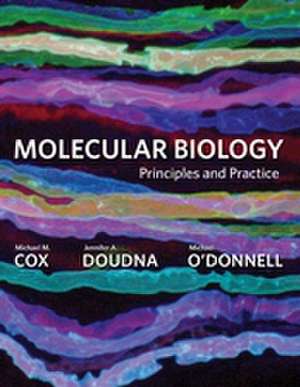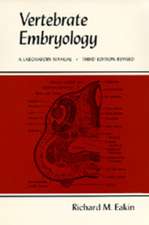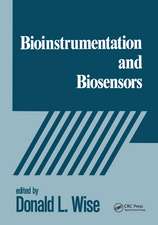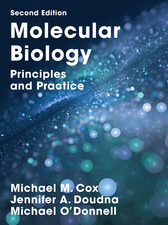Cox, M: Molecular Biology
en Limba Engleză Hardback – 30 noi 2011
Key features include:
Moment of Discovery
Each chapter opens with a description of a significant breakthrough in molecular biology relevant to that chapter, as told by the scientist who made the discovery. They make this a relevant, living subject to students.
Examples include:
- Joe DeRisi, on his discovery of the SARS virus (Chapter 8)
- Melissa Jurica, on her discovery of the first EM structures of spliceosomes (Chapter 16)
- Bonnie Bassler, on her discovery of interspecies quorum sensing (Chapter 20)
How We Know
This end-of-chapter section combines fascinating stories of research and researchers with actual experimental data for students to analyze, often drawing on the work of the scientist featured in the chapter's 'Moment of Discovery.' This ensures the material covered in the book is always shown to be relevant to how scientists really work.
Unanswered Questions
A short section at the end of each chapter describes important areas still open to discovery, showing students that even well-covered subjects such as nucleic acid structure and DNA replication are far from fully explored. This emphasises the evolving nature of the subject and show students how their work could have impact in the future.
Key Conventions
These brief paragraphs clearly lay out for student some fundamental principles often glossed over by instructors and textbooks because they are so well understood by professionals. They are helpful to students, who could otherwise be thrown by such assumptions.
Highlights
Throughout each chapter, special features focus on fascinating topics that enhance student understanding of the concepts:
• Medicine looks at diseases that arise from defects in biochemical pathways, or examples of how concepts learned in molecular biology have contributed to drug therapies or other treatments.
• Technology focuses on cutting-edge molecular biology methods that students will likely be hearing about or even using in the future.
• Evolution reveals the role of molecular biology research in understanding key biological processes and the connections between organisms.
• A Closer Look highlights a wide variety of additional, intriguing topics.
• Encourages practice and critical thinking
End-of-Chapter Problems
These give students the opportunity to think about and work with the chapter's key ideas. Each problem set concludes with a Data Analysis Problem, giving students the crucial experience of interpreting real data from actual research (most often the work described in the 'How We Know' section). Solutions to the problems can be found at the end of the book.
(This title may not be available in all areas. Please contact your representative for more information.)
| Toate formatele și edițiile | Preț | Express |
|---|---|---|
| Hardback (2) | 43.24 lei 3-5 săpt. | |
| Bloomsbury Publishing – 31 ian 2007 | 43.24 lei 3-5 săpt. | |
| MACMILLAN EDUCATION – 30 noi 2011 | 263.78 lei 3-5 săpt. |
Preț: 263.78 lei
Nou
Puncte Express: 396
Preț estimativ în valută:
50.48€ • 54.81$ • 42.40£
50.48€ • 54.81$ • 42.40£
Carte disponibilă
Livrare economică 01-15 aprilie
Preluare comenzi: 021 569.72.76
Specificații
ISBN-13: 9781464102257
ISBN-10: 1464102252
Pagini: 750
Ilustrații: 1300 illustrations
Dimensiuni: 138 x 216 x 26 mm
Greutate: 2.0099999999999998 kg
Editura: MACMILLAN EDUCATION
Locul publicării:New York, United States
ISBN-10: 1464102252
Pagini: 750
Ilustrații: 1300 illustrations
Dimensiuni: 138 x 216 x 26 mm
Greutate: 2.0099999999999998 kg
Editura: MACMILLAN EDUCATION
Locul publicării:New York, United States
Cuprins
PART I: FOUNDATIONS
Studying the Molecules of Life
DNA: The Repository of Biological Information
Chemical Basis of Information Molecules
Protein Structure
Protein Function
PART II: NUCLEIC ACID STRUCTURE & METHODS
DNA and RNA Structure
Studying Genes
Genomes, Transcriptomes, and Proteomes
Topology: Functional Deformations of DNA
Nucleosomes, Chromatin, and Chromosome Structure
PART III: INFORMATION TRANSFER
DNA Replication
DNA Mutation and Repair Moment of Discovery
Homologous Recombination
Site-Specific Recombination and Transposition
DNA-Dependent Synthesis of RNA
RNA Processing
The Genetic Code
Protein Synthesis
PART IV: REGULATION
Regulating the Flow of Information
The Regulation of Gene Expression in Bacteria
Transcriptional Regulation of Gene Expression in Eukaryotes
Post-Transcriptional Regulation of Gene Expression in Eukaryotes
Gene Regulation in Development
Online Appendix: Model Organisms
Studying the Molecules of Life
DNA: The Repository of Biological Information
Chemical Basis of Information Molecules
Protein Structure
Protein Function
PART II: NUCLEIC ACID STRUCTURE & METHODS
DNA and RNA Structure
Studying Genes
Genomes, Transcriptomes, and Proteomes
Topology: Functional Deformations of DNA
Nucleosomes, Chromatin, and Chromosome Structure
PART III: INFORMATION TRANSFER
DNA Replication
DNA Mutation and Repair Moment of Discovery
Homologous Recombination
Site-Specific Recombination and Transposition
DNA-Dependent Synthesis of RNA
RNA Processing
The Genetic Code
Protein Synthesis
PART IV: REGULATION
Regulating the Flow of Information
The Regulation of Gene Expression in Bacteria
Transcriptional Regulation of Gene Expression in Eukaryotes
Post-Transcriptional Regulation of Gene Expression in Eukaryotes
Gene Regulation in Development
Online Appendix: Model Organisms
Notă biografică
MICHAEL M. COX is Professor of Biochemistry, University of Wisconsin-Madison, USA. His research focuses on recombinational DNA repair processes. In addition to the work on this text, Cox is a co-author of four editions of Lehninger Principles of Biochemistry. He has received awards for both his teaching and his research, including the 1989 Eli Lilly Award in Biological Chemistry, and two major teaching awards from the University of Wisconsin, USA, and the University of Wisconsin System.
JENNIFER A. DOUDNA is Professor of Molecular and Cell Biology and Professor of Chemistry at the University of California, Berkeley, USA, and an Investigator of the Howard Hughes Medical Institute. She has received numerous awards for her research on RNA and RNA-protein structure and function, including the Johnson Foundation Prize for innovative research, the National Academy of Sciences Award for initiatives in research, the Alan T. Waterman Award from the National Science Foundation, and the Eli Lilly Award in Biological Chemistry from the American Chemical Society.
MICHAEL O'DONNELL is at the Rockefeller University, USA. He is a member of the National Academy of Sciences.
JENNIFER A. DOUDNA is Professor of Molecular and Cell Biology and Professor of Chemistry at the University of California, Berkeley, USA, and an Investigator of the Howard Hughes Medical Institute. She has received numerous awards for her research on RNA and RNA-protein structure and function, including the Johnson Foundation Prize for innovative research, the National Academy of Sciences Award for initiatives in research, the Alan T. Waterman Award from the National Science Foundation, and the Eli Lilly Award in Biological Chemistry from the American Chemical Society.
MICHAEL O'DONNELL is at the Rockefeller University, USA. He is a member of the National Academy of Sciences.
Caracteristici
A highly engaging textbook that captures student attention
Award-winning authors
Focus on fundamental principles that can be learned by students at all levels
Award-winning authors
Focus on fundamental principles that can be learned by students at all levels













